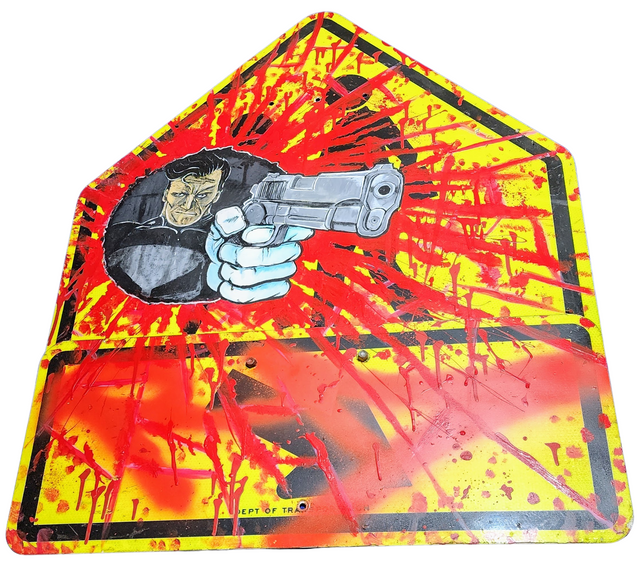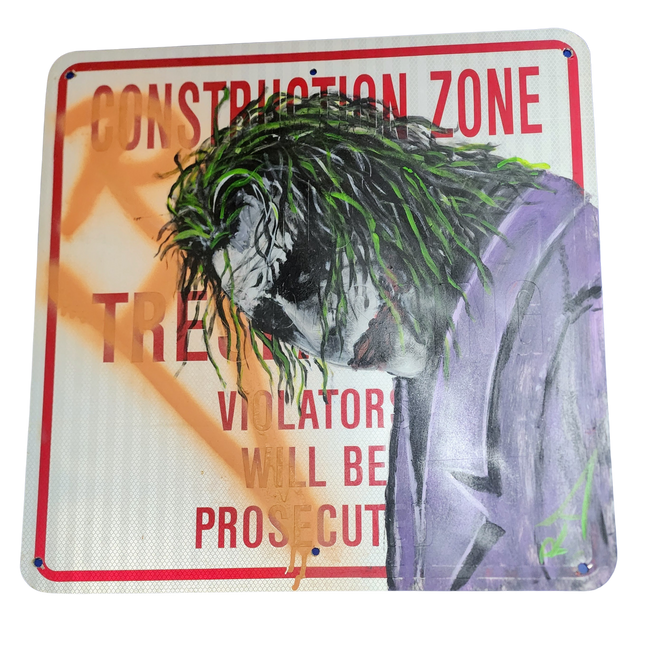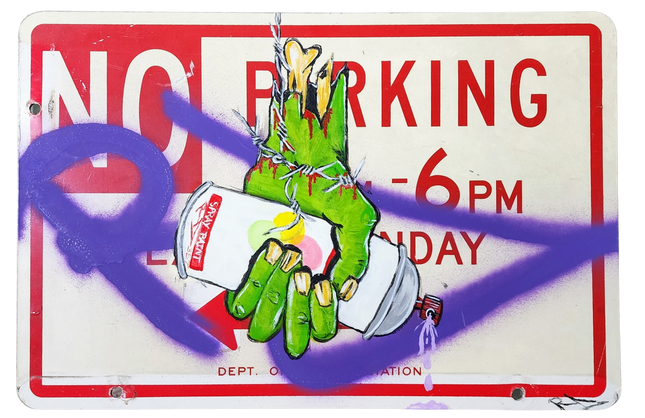
Street Signs

RD-357 Real Deal Ledger Joker Construction Street Sign Painting by RD-357 Real Deal
Heath Ledger Joker Construction Zone Original Street Sign Painting by RD-357 Real Deal One of a Kind Artwork on Real Metal NYC New York Construction Zone No Trespassing Street Sign by Graffiti Art Pop Artist. 2012 Signed Mixed Media Acrylic & Spray Paint on Reclaimed NYC New York Construction Zone No Trespassing Sign Painting Original Artwork Size 24x24 Batman Villian Played by Heath Ledger in the Movie as Joker Looking at the Viewer. RD Tag in Rust Red. RD-357's Heath Ledger Joker: A Fusion of Street Pop Art and Iconography The Heath Ledger Joker Construction Zone original street sign painting by RD-357, also known as Real Deal, encapsulates the essence of street pop art through its provocative use of public signage repurposed for artistic expression. Created in 2012, this mixed media acrylic and spray paint artwork transforms a New York City construction zone 'No Trespassing' sign into a canvas, depicting the iconic Batman villain played by Heath Ledger in a way that both challenges and captivates the viewer. Contextualizing RD-357's Artistic Approach RD-357, an artist whose real name remains elusive in the true spirit of street art anonymity, is known for his gritty interpretations of pop culture figures on unconventional canvases. This particular artwork measures 24x24 inches and is a testament to street art's versatility, pushing beyond traditional boundaries. RD-357 draws upon the anarchic spirit of the Joker, using a symbol of law and order – a construction sign – to present an image of chaos and rebellion. The irony is palpable; the sign, which once stood as a warning against unauthorized entry, now invites viewers to engage with the art in a personal, almost aggressive manner. Symbolism and Impact in RD-357's Joker Artwork This piece is not just a portrait; it is a statement. By choosing Heath Ledger's Joker, RD-357 taps into the collective consciousness of a society fascinated by the anti-hero archetype. Ledger's portrayal of the Joker was posthumously celebrated, and his death in 2008 left a cultural imprint that RD-357 leverages in this artwork. The juxtaposition of the Joker’s figure against the backdrop of a New York construction sign speaks volumes about the chaotic undercurrents within the perceived order of urban life. The use of mixed media, with acrylic and spray paint, highlights street art's raw, visceral nature, while also paying homage to the vibrancy of pop art. The viewer is confronted with the Joker's gaze, which, coupled with the bright warning colors of the construction sign, creates an unsettling yet magnetic presence. This interaction compels the audience to contemplate the layers of meaning behind the piece – from transforming public property into a medium for personal expression to the dialogue between art and spectator that challenges societal norms and the very definition of public space. In conclusion, RD-357's Heath Ledger Joker on a New York City construction sign is an outstanding example of how street pop art can merge cultural iconography with subversive messaging. Through this piece, the artist immortalizes a beloved film character and raises questions about authority, ownership, and the role of art in public discourse. The artwork remains a one-of-a-kind testament to the power of graffiti art to redefine spaces and provoke thought long after the paint has dried.
$3,000.00

RD-357 Real Deal Zombie Hand Tag Original Street Sign Painting by RD-357 Real Deal
Zombie Hand Tag Original Street Sign Painting by RD-357 Real Deal Spray Paint Mixed Media One of a Kind of Artwork on New York City No Parking Notice Sign Pop Graffiti Street Art Artwork. 2014 Signed Spray Painting Original Artwork on Real NYC Reclaimed No Parking Metal Urban City Street Sign Size 18x12 of a Decapitated Zombie Hand Grasping & Spraying a Can of Krylon Spray Paint with the RD Tag in Purple. RD-357's Vivid Depiction of Urban Rebellion: The Zombie Hand Tag The 'Zombie Hand Tag' original street sign painting by RD-357, also known as Real Deal, is a provocative piece of street pop art and graffiti that embodies the rebellious spirit of urban street culture. Completed in 2014, this artwork uses a New York City 'No Parking' metal sign as its canvas, transforming a mundane object of urban regulation into a striking visual statement. The depiction of a decapitated zombie hand grasping and actively using a can of Krylon spray paint infuses the piece with a sense of post-apocalyptic creativity and survival. Interpreting the Symbolism in RD-357's Art This piece is rich with symbolism that resonates with the ethos of graffiti and street pop art. The zombie hand, often a symbol of horror and the macabre, is presented here as a vessel of artistic creation, subverting its usual connotations of death and decay. By wielding a can of Krylon, the hand breathes life into an art form that thrives on the fringes of society. The RD tag in purple spray paint marks the artist's signature and serves as an act of claiming territory, a fundamental aspect of graffiti culture. The choice of a 'No Parking' sign as the medium is deliberate and insightful. It represents the restrictions and boundaries imposed by society, which street art often aims to transgress. The act of a zombie hand, a symbol of defiance against mortality, spraying over such a sign is a metaphor for the resilience of street art. It refuses to be confined or controlled, much like the undead refusing to remain in the grave. The Aesthetics and Technique in RD-357's Zombie Hand Tag RD-357's technique in creating this piece highlights street art's raw and unapologetic beauty. The artwork, measuring 18x12 inches, showcases the artist's skill in manipulating spray paint, a medium often dismissed by the traditional art world but revered in street culture. The dripping paint from the Krylon can, the textured portrayal of the zombie flesh, and the striking contrast between the hand and the sterile sign it occupies all contribute to a composition that is as much a visual triumph as a statement piece. The use of mixed media, incorporating both the physical sign and the spray paint, reflects the layered nature of street art. It is both an object and a message, a tangible piece of the city's fabric and a commentary. The artwork challenges viewers to see beyond the surface to understand the depth and complexity of the messages conveyed through this unique artistic expression. Conclusion: The Cultural Impact of RD-357's Work The 'Zombie Hand Tag' is a potent example of how street pop art and graffiti can alter perceptions and engage with viewers on a visceral level. RD-357's work demonstrates street art's transformative power, which can turn a simple traffic sign into a thought-provoking piece that questions authority and celebrates the irrepressible nature of human creativity, even in the face of societal collapse. RD-357, whose real name and country of origin remain unknown, much like the enigmatic nature of street art itself, has created a piece that stands as a testament to the enduring spirit of street pop art and graffiti. The 'Zombie Hand Tag' is a visual spectacle and a narrative of resistance, a declaration that even in a world overrun by the metaphorical zombies of conformity and control, the artist's spirit remains unvanquished.
$600.00



